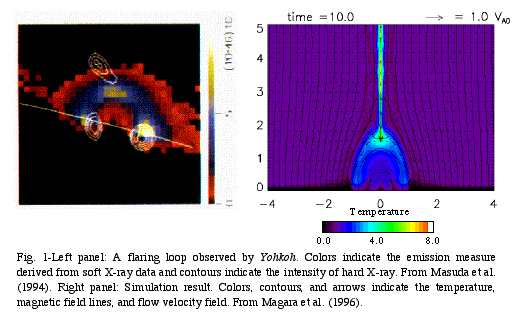

This work is based on a new observational result found by Yohkoh, that is a hard X-ray source appearing over soft X-ray flaring loop in compact flares (Masuda et al. 1994; left panel in Figure 1). In order to explain the formation process of this loop-top source, we investigated dynamical aspects of the so-called CSHKP model, a famous solar flare model based on magnetic reconnection, by performing 2-dimensional MHD numerical simulations. The result is that a plasma jet originating from a reconnection point collides with the underlying closed loop to form a fast-mode MHD shock, behind which a hot and dense core appears (Magara et al. 1996; right panel in Figure 1). The temperature of this core is consistent with the value derived from hard X-ray data (about hundred million degrees) if the thermal radiation is assumed (Magara 1998). We also proposed that the different appearance between short-lived flares (impulsive flares) and long-duration flares (LDE flares) reflects how the magnetic reconnection works in individual flares (Magara et al. 1996).
Magara, T., Mineshige, S., Yokoyama, T., & Shibata, K. 1996, ApJ, 466, 1054
Magara, T. 1998, Ph. D. Thesis, Univ. Kyoto
Masuda, S., Kosugi, T., Hara, H., Tsuneta, S., & Ogawara, Y. 1994, Nature, 371, 495